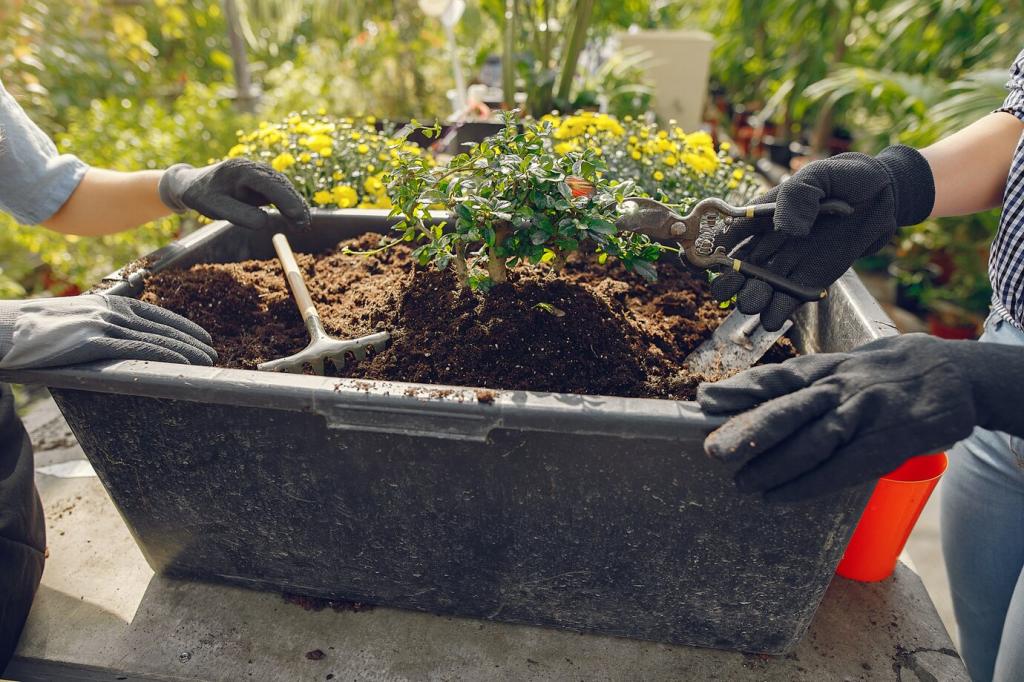Water-Wise Landscaping Techniques: Beauty That Saves Every Drop
Designing a Drought-Resilient Yard
01
Walk your property after a light rain and note where water lingers, races, or disappears. Track sun patterns and wind corridors. This simple detective work helps position plants, paths, and beds so moisture stays where roots need it most.
02
Group plants by water needs—high, moderate, and low—so irrigation is tailored, not wasted. Keep thirstier edibles close to the house and drought-tough natives further out. Hydrozoning reduces guesswork and unlocks easy, measurable savings every single week.
03
Our reader Maya transformed a narrow curb strip from water-hungry turf into a gravel-mulched bed with native yarrow and penstemon. After one season, runoff vanished, butterflies showed up, and her bill dropped noticeably. Share your strip success story next!
Smart Irrigation That Thinks Before It Sprinkles
Swap broad-spray sprinklers for drip lines that feed roots directly. Use adjustable emitters at one to two gallons per hour for trees and shrubs. Expect less evaporation, fewer weeds, healthier soil structure, and a calmer, quieter garden rhythm.
Smart Irrigation That Thinks Before It Sprinkles
Install a smart controller that reads local weather or evapotranspiration data, then adjusts run times automatically. Add soil moisture sensors to prevent unnecessary cycles. Together they turn irrigation into a responsive system, not a rigid schedule.




Plants That Flourish on Less
Start with native shrubs and perennials that evolved for your rainfall patterns. Think salvia, ceanothus, and milkweed in many Western gardens. They invite bees, birds, and butterflies while thriving on modest irrigation once established.
Plants That Flourish on Less
Agaves, aloes, yuccas, and ice plants add bold silhouettes and shimmering foliage. Mix fine-textured grasses like blue fescue for contrast. These resilient choices store water, shrug off heat, and keep the garden sculptural when rain is scarce.
Soil, Mulch, and Moisture Mastery
Blend finished compost into planting areas to boost organic matter and microbial life. Better aggregation means water infiltrates quickly and stays accessible longer. Roots dive deeper, and irrigation intervals stretch further without stressing plants.
Soil, Mulch, and Moisture Mastery
Apply two to three inches of organic mulch around perennials and shrubs, keeping it off stems. In arid climates, mineral mulches like gravel reflect heat less and last longer. Either way, you slash evaporation and discourage weeds effectively.
Soil, Mulch, and Moisture Mastery
Use small basins at trees, low berms along beds, and subtle swales on slopes. These earthworks slow runoff and give water time to soak. They’re simple, beautiful, and endlessly customizable to your garden’s contours.

Rain Barrels and Right-Sized Cisterns
Install downspout diverters feeding barrels for small gardens, or plumb to larger cisterns for serious storage. Add first-flush filters and overflow routes into planted basins. You’ll bank free irrigation for dry spells without lifting a hose.

Passive Capture With Rain Gardens
Shape shallow depressions planted with tough natives to receive peak flows. Integrate amended soils and overflow paths. Rain gardens slow water, filter pollutants, and turn downpours into quiet recharge moments for your landscape and local aquifer.

Graywater Basics and Good Sense
Where legal, redirect laundry or shower water to mulch basins for trees and ornamentals, never edibles. Use plant-friendly detergents and follow local codes. It’s a smart supplement that reduces potable demand while protecting soil health.
Low-Water Hardscapes With Heart
Permeable Surfaces That Sip, Not Shed
Opt for permeable pavers, decomposed granite, or spaced flagstone with gravel joints. They invite rainfall to sink beneath your feet instead of racing to the street, reducing puddles, glare, and heat while nourishing nearby roots.
Shade Structures That Save Moisture
Pergolas, trellises, and well-placed trees reduce leaf scorch and evapotranspiration. Cooler microclimates mean plants lose less water and people linger longer. Blend deciduous shade near windows to welcome winter sun and protect summer afternoons.
Paths That Guide Water Wisely
Pitch walkways subtly toward planted areas or swales. Add edging that nudges runoff into basins instead of drains. Thoughtful grading turns a simple path into a quiet partner in your water-wise strategy.
